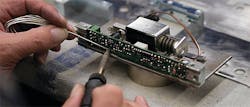The physical security industry is rapidly changing. Not only are there changes in locking hardware, we are seeing rapid evolution in surveillance technology – all driven by advancements in network capacity and speed. More bandwidth capacity and faster transmission speeds are driving more advanced access control options like integration with biometrics such as facial recognition, body configuration, along with combining video with credentials.
The development of low powered propulsion for lock mechanisms is another emerging trend. Back in the 1960s and 1970s, for example, commercial electric strikes had solenoids so large they had to be mounted on the outside of the case. Exit devices required specialized circuitry to provide the high amperage necessary to retract the latching mechanism.
Today, however, solenoids are mounted inside the electric strike case. There are solenoids that have an in-rush current draw of less than 400mA and holding force of less than 50mA. This is a significant improvement.
Over the years, electric motors have decreased in size and increased in power and efficiency. Motor technology has improved to the level where they are able to replace a solenoid in an exit device and mortise lock. Exit device customers appreciate the fact that this advancement has eliminated the clanging sound that would occur when the solenoid retracted. When you also consider that the electric motor does not require a surge of power, which would often result in less power being drawn for operation and reduced power for holding force, replacing the solenoid is certainly a preferred option. With this option you can operate more devices on a single power supply and eventually migrate the locking system to power over Ethernet.
For those lock devices already on your customers doors, reduction modules, developed in the early 2000s, will deliver enough current for a solenoid to remain actuated almost indefinitely without requiring large power supplies and heavier gauge wires. These modules, like motors and solenoids, continue to become more efficient. Locks and exit devices benefit from the advanced motor technology by running cooler, increasing the operational life of both the solenoids and motors. Over the years, these devices have also increased their ability to fine tune the current in order to maximize efficiency.
By reducing the required power, the locksmith or security technician may be able to reduce the number of wire runs necessary to operate an opening and in the process reduce the number and amperage requirements of power supplies.
About the Author:
Jerry Levine is the Technology Editor for Locksmith Ledger International magazine.


